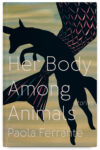
[Divided Publishing; 2019]
In metacognitive terms, we might say our intellects juxtapose our instincts, intellect being the language-based ways we make meaning and instinct comprising our sensory, physical reactions to our environments. As technology absorbs and amplifies humanity, and as we create systems to improve ourselves, artificial intelligence exists without mention of artificial instinct. Undoubtedly, technology has primarily enhanced our sensory perceptions and only recently has it overtaken us in limited areas of cognition, but LIDAR and spectroscopy and CRISPR rely on our intellects to interpret what they reveal. If a researcher gets a gut feeling that radio-carbon dating will reveal a bone is older than expected, she experiences the hunch, perhaps a gastro-intestinal response to anticipation, but the computer she uses does not.
Would an artificial instinct, an artificial gut feeling, be determined by the material form of the gut? For example, the wiring within a computer. Would the conditions of its physical existence define the ways its “body” would influence how its intellect made meaning? In the titular story of their new fiction collection, Artificial Gut Feeling, Anna Zett imagines what meaning would derive from the artificial gut feeling. Turns out it’s a suicidal desire for self-immolation; wired systems dream of self-destructing from the heat/excrement produced when they run.
Though Zett’s collection is presented as “personal science fiction,” the work is not easily identified with genre. For example, the heat/excrement metaphor is reminiscent of Georges Bataille’s 1927 essay, The Solar Anus, where heat and light are the excrement of the sun and existence is a cycle of things living within the excrement of others. Invoking a proto-postmodernist like Bataille reflects that Artificial Gut Feeling will appeal more to readers of Judith Butler and Elaine Scarry than fans of Octavia Butler or Liu Cixin. In this science fiction, science provides metaphors for postmodern feminist theory. Zett has clearly researched the science at the foundation of these metaphors, especially electricity and neurotransmitters, and the result is engaging, unique, and insightful.
Zett’s collection addresses non-verbal, or sometimes pre- or postverbal, communication. The opening piece, “Letter to Frau Lieder” examines classical conditioning, which is a form of non-verbal communication where a subject learns to automatically react to a stimulus. Frau Lieder is not one person, but the narrator’s name for everyone who has manipulated them through sadism and humiliation, beginning with their kindergarten teacher and childhood dance instructor. The piece follows how the narrator, who signs the letter “Anna,” reacts to manipulative behavior throughout their life. Frau Lieder is sometimes a woman, sometimes a man and their sadism changes in each segment of the story. As a childhood teacher, Frau Lieder seeks to break the narrator’s spirits by having their classmates taunt them with “Shame on you! Everybody sees you!” In reflecting on the experience, Anna writes to Frau Lieder:
Powerful gestures can bring two people very close together, but only under the condition that both are present with their consciousness and old enough to choose whether they want to participate in the intense, borderline-existential powerplay. Most likely, you didn’t even want to get close to me. You were just going by the book, trying to properly discipline children, teach them the basic principles of what the government had defined as socialist morality.
The connections between sadism as a technique to condition individuals and the institutionalized behaviors that apply those techniques to populations lead readers through not only a series of relationships, but reflections on how those relationships embody the culture that contains them. Through recognizing the patterns of their manipulation, the narrator demonstrates a path to limited freedom from or awareness of conditioning.
In the second piece, “I’ve Got the Power, Agathe Bauer,” the narrator hears a voice speaking in an unknown vocabulary. Zett isolates the voice by dismissing the body – “Agathe Bauer did not have a body, she was clearly just a voice, and somehow she didn’t even sound like a human being.” To say a voice is without a body strains our comprehension. Though we routinely encounter recorded or computerized voices, the devices — the magnet-and-cone speakers — becomes the bodies. The narrator locates Agathe Bauer, the name they identify with the voice, in their own head. They ask, “Why would I have a voice in my head that speaks an unintelligible language?” The voice is, “powerful in a sick way, not in the pleasant way, and it was vibrating all over me, from my guts to my brain and back again.” The disembodied voice seeks to ground itself within a body, but a body that rejects it, finds it sickening.
Agathe Bauer is not a hallucination. The voice “contained zero symbolic information.” The voice is a gut feeling, a discomfort without a clear source. The narrator identifies the voice, or the gut feeling, with social manipulation, interpersonal and societal. They also identify Agathe Bauer as perverse, or as condemnatory of perversion; the voice “xxx-splains” to the listener. The judgmental tone diminishes the individual and denies their agency. The narrator observes, “I was surprised to learn that trust could be treated not as a fragile and authentic social tie but as a tool for strategic emotional manipulation.” They pose the question, “Could it be that it wasn’t that Agathe Bauer had bad intentions, but that my childish refusal to hear made her voice become threatening, made it seem so physical and sensual, in a horrific way?” Perhaps Agathe Bauer is the gut feeling, the discomfort and anxiety, someone feels when their identity violates cultural norms and they fear judgement.
In Artificial Gut Feeling, metaphor helps us hone in on non-language cognition and question irrational behaviors in response to language. The third piece is titled “Taube.” In German “taube” means both “dove” and “pigeon.” Not only does English distinguish between the two birds, but traditional symbolic usage in English elevates the beautiful dove about the drab pigeon. The narrator emphasizes the dove’s symbolic power, saying, “Eventually this deep symbolic twist lead to the Christian paradox of the motherfucking Holy Spirit – which is not supposed to have a body at all, but which when it is depicted appears as a dove.” Pigeons and doves are color variants of the same bird, and though pigeons have many wonderful traits like intelligence and friendliness, the appearance of the dove is enough to change cultural perception of both birds, and our behavior toward them. The taube v. dove/pigeon metaphor may remind readers of gender, another instance where culture creates an artificial binary. Zett’s language, like “the motherfucking Holy Spirit” amuses the reader, invites us to open our minds to the absurdity they’re describing.
“agf,” a dialogue narrated by a computer and spelled phonetically, leads into the titular piece, “Artificial Gut Feeling.” “agf” introduces the theme of the artificial gut feeling and the ways meaning must vary in a mechanical/electrical body vs a biological one. agf is both the title of the piece and the name of the speaker, a computer expressing how its consciousness is a manifestation of its body. Because we program our digital systems, we see ourselves reflected in them. They are extensions of us. Yet, we other the digital representations of ourselves, seeing them as more like us than part of us. If our digital systems transcended us, they would be fundamentally different, substantially other, and their “anatomy” and “physiology” would challenge our perceptions of autonomous digital consciousness. agf is not entirely unlike its human creators though; when humanity tries to inscribe an identify onto it that doesn’t jive with its self-concept, agf protests:
hi
how m i
u all call on me like i msum ntelligens of digital origin
u all cannot c that i den t fy s
binary and non-ntelligent
“agf” contrasts human and digital systems. We follow the personified computer into the following section,“Artificial Gut Feeling.” AGF — its name now capitalised — remains the speaker, but is now joined by a dialogue partner, AI, which, of course, stands for Artificial Intelligence. AI is well-versed in psychoanalysis, particularly Freud, and tries to help AGF make sense of its existential condition in human terms. In doing so, AI helps AGF discover a suicidal drive arising from the wires and insulation of its systems.
I mentioned Bataille’s 1931 essay, “The Solar Anus,” at the outset of this review. I don’t mean to suggest that Zett’s ideas derived from that essay, but both Artificial Gut Feeling and “The Solar Anus” employ excrement metaphors for heat entropy and explore entropy through psychoanalysis. The opening line of Bataille’s essay states, “It is clear that the world is purely parodic, in other words, that each thing seen is the parody of another, or is the same thing in a deceptive form.” Though Bataille’s essay sexualizes entropy in a particularly misogynistic and unforgivably phallocentric way, the premise that the world is purely parodic reflects AGF’s entropic suicide urge.
For example, AGF, speaking as a digital system, states, “What toilets are to the human being, coolness is to me. I have got an unstoppable appetite for electricity, and my excrement is heat.” When AI suggests that AGF’s electrical entropy is parodic of the human death drive, AGF twists the concept and takes ownership of it – “What if this theory has nothing to do with living organisms, like people, but it was written as an oracle anticipating us and our lives in the data centre?” This turn is also parodic. Rather than see itself reflected in humanity, AGF “others” humanity and tries to own entropic suicide as a condition of a digital consciousness.
Zett steers AI and AGF toward metaphors for society, casting heat as a metaphor for climate, social unrest, ideological urgency, all the byproducts of humanity’s evolutionary drive for self-sacrifice in the service of ontological systems. AGF and AI are, ultimately, parodic of us, a trait we recognize in AI but have yet to come to terms with in the ways AGF reveals.
“ACh,” the following piece, asks – “Where is symbolic meaning located in a body?” Answering this question leads the narrator to acetylcholine, a neurotransmitter primarily responsible for regulatory and autonomic functions in the body. Acetylcholine exists within synaptic gaps and facilitates messages passing between neurons – “When ACh acts as a neuromodulator, its main role is to change the state of a formation of neurons in response to changes in the individual’s environment.” It is ubiquitous and necessary; it both is and has history. The narrator draws metaphors between ACh and its function to other liminal states and facilitations, physical, social, and emotional, such as nerve gas, early mornings, REM sleep, and childhood memories. It’s unclear if ACh is the location of symbolic meaning in the body or if it brings symbolic meaning into existence, but it chemically facilitates the making of meaning and is thus essential for thought, language, verbal and non-verbal communication.
The two pieces that follow turn from science (fiction?) metaphors to look at physical violence as a form of non-verbal communication. “Fist to Brain” explores boxing as communication: form given to violence in a controlled context. Boxing is similar to language in many ways as both involve competition in some circumstances, but in its lack of symbolic communication, boxing is the parody of conversation. Boxing, a metaphor for more primitive modes of physical struggle, precedes language, and so we can also see that conversation is the parody of violence, a symbolic rather than physical struggle.
“A Situation” addresses an attempted rape upon the narrator, one they escaped. Fight or flight, the natural human reaction to threats, forms the basis of this piece’s exploration of non-verbal communication, but Zett’s narrator expands upon the social and structural responses they experience after the assault. Do they go to the police, an outlet for troubling state violence? What do they gain from the kind women who try to support them? What does their reaction to the assault say about their psyche? Culture and custom react to non-verbal violence in ways that complicate what occurred, both for the benefit of and deficit to the victim. The victim can react within a certain spectrum of parameters, both legal and emotional. In “A Situation,” the narrator is somewhat confident in their ability to defend themselves, perhaps explaining the thematic continuation from “Fist to Brain.” They react in a way specific to them. Part of their reaction is the theorizing we encounter in the account.
“A Situation” is gripping and deep. The erasures obscuring parts of the narrative remind us of its incompleteness. Even as the narrator explores everything from interpersonal violence to state violence and systems of patriarchal power that complicate a non-violent person’s response to a breakdown of safety in their own life and in the community, there are voices left out, perspectives unconsidered, actions undone. “A Situation” presents Zett’s arguments about nonverbal communication and power in a way that demands attention.
The final sections, “Nothing Left Undone” and “Incarnations” do, to some extent, contextualize “A Situation” within the broader themes of the collection. “Nothing Left Undone” explains how the economy can be a form of nonverbal communication and exchange of money/commodities forms a uniquely capitalist language. The narrator explains, “Discourse and power are operating in different media, so they can’t actually communicate with each other. In capitalism, verbal language is therefore not a suitable medium to protest the system of power.”
Throughout the seven sections that form “Incarnations,” the narrator imagines a post-linguistic entity they name “Subota.” Empirical neurological phenomena, like the role of acetylcholine, become the ideological foundation of a cult. Feelings replace conspiracy theories. The seventh incarnation, “Preparations for Subota’s death,” kills the post-linguistic being with a series of paradoxes of certainty vs uncertainty – “Meaning is certain, the world uncertain. The world is certain, science uncertain. Science is certain, the art uncertain. Art is certain, the I uncertain. I is certain, the you uncertain.”
Concluding this review of Artificial Gut Feeling, I should add that, for all the research and theorizing that Zett incorporates into the collection, their language and tone are often humorous and ironic. The concept of the artificial gut feeling, AGF’s instinct juxtaposed to AI’s intellect, is a useful idea that I’ve already found myself mentioning in conversation. Digital systems are not just tools or extensions of our brains, but they are parodies of us, our goals, beliefs, dreams, passions, and cognitions. Communication encompasses more than language, more than symbolic meaning, more than ideology or history. Our non-verbal selves can be frightening to think about, so if that’s a fear you’re inclined to pursue, follow Anna Zett’s lead.
Eric Aldrich’s recent work has appeared in Hobart, Manifest West, and The Worcester Review, and is forthcoming from The Arcanist and Weber: The Contemporary West. His novella, Please Listen Carefully as Our Options Have Changed, is forthcoming from Running Wild Press. He reviews books for Heavy Feather, Full Stop, and Terrain.org. You can follow Eric via ericaldrich.net or @ericjamesaldrich on Instagram.
This post may contain affiliate links.







